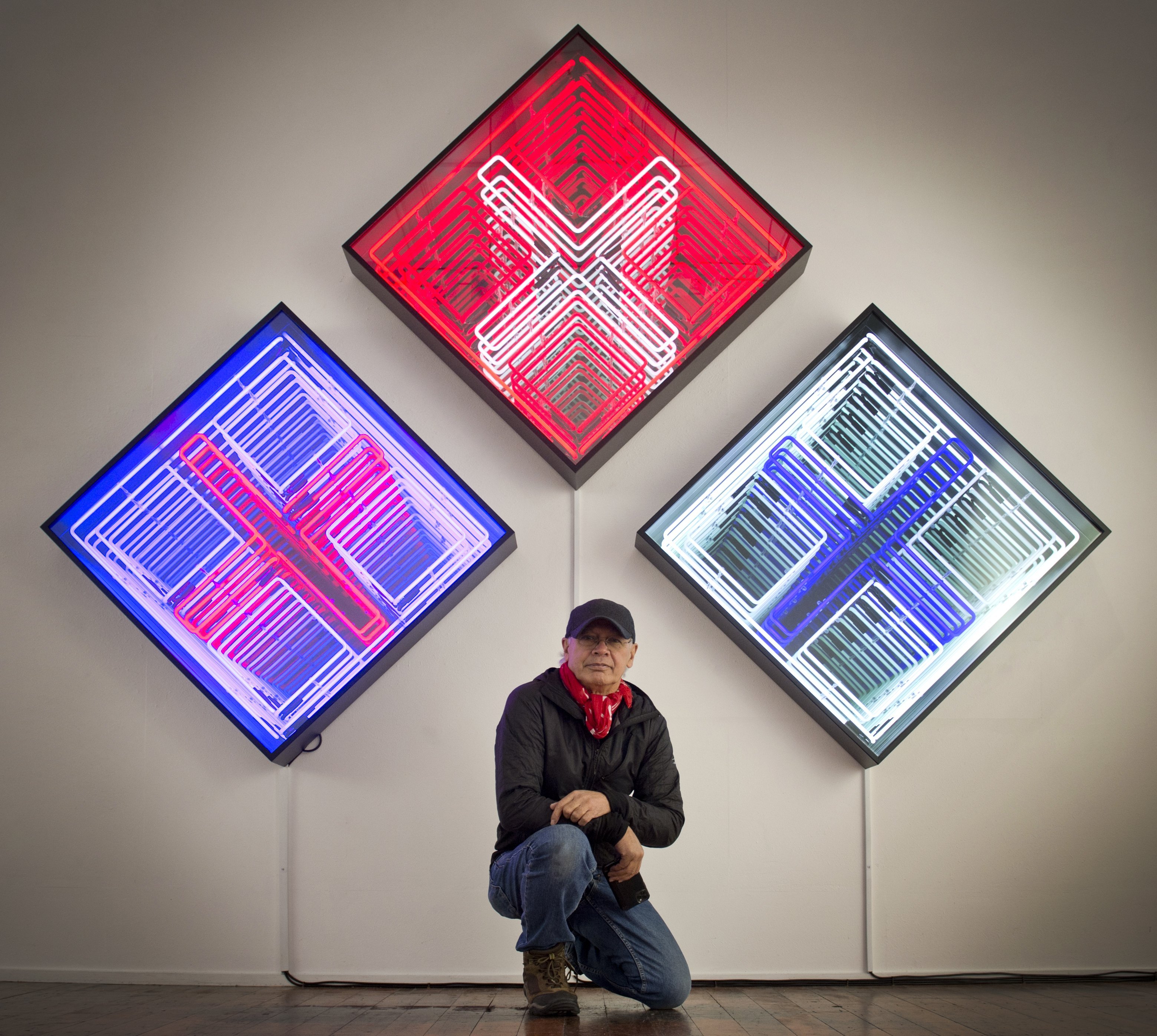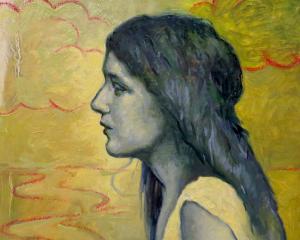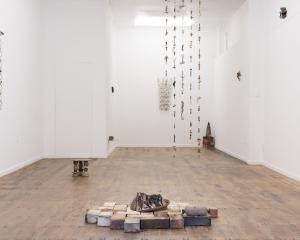
An "X" or cross can symbolise many things - Christianity, a signature, death or racist stance.
It is a motif at the centre of artist Robert Jahnke’s latest exhibition "Mata Puare - the Awakening" at Milford Galleries Dunedin.
"It means to open one’s eyes. It’s about activating the senses to, in a sense, engage in narratives that are based on Maori relationships with land."
Using light and colour, Jahnke (Ngai Taharora, Te Whanau a Iritekura, Te Whanau a Rakairo o Ngati Porou) has created a series of neon light installations with the cross in various forms at the centre.
"The cross is an interesting image. It’s got negative connotations and positive connotations depending on the context in which you use it."
He then puts the cross within other shapes, such as circles or diamonds, to evoke different messages.
In three works - Mata kahurangi, Mata ma and Mata whero - Jahnke uses the cross framed in a diamond shape "taking the graphic images which are universal in terms of cultures" and marrying together narratives associated with the diamond pattern in Maoridom, which is symbolised in the star constellation Patiki.
"It is a pattern that is association with propitious gathering of flounder... it becomes like a image about relationships with Maori predicting and foreseeing future developments."
He says it also focuses the conversation towards a Maori narrative because when signing the Treaty of Waitangi those who were not literate often signed with a cross, those that were, signed their name and others used their ta moko.
There were different modes of ascension to what the Treaty was supposed to represent at that time and in the end it did not fulfil its promises.
"In a sense there is a covenant or promotion of this relationship and this responsibility we have as tangta whenua to, in a sense, engage and to honour this covenant."
He is also "having a dig" at Christianity, something he has done many times in his works, as in the works the cross is tipped over.
"One thing with Christianity, they appropriated the diamond and so went from symbolising the constellation to symbolising Christ as a fisher of men."
His new circle works - Purehuroa Ma (white cross) and Purehuroa Kahurangi (blue cross) - are a development on two earlier works, Ground Zero and Whenua Kore.
Ground Zero was a work exhibited on Waiheke Island and used a circle as a bulls-eye.
"I kind of created a work that people could ascend the staircase, walk around the work and look into the work itself and walk over it. It was a very interactive piece."
Whenua Kore, which means landless, was a "minimalist creation of that", similar to his new works, but much bigger in scale.
"The sculpture became a marker that was placed on land that no longer belonged to Maori."

However, in the new circle works the inclusion of the cross is about engaging with the notion of mana whenua, even when Maori no longer own the land.
"It’s about aspiring towards the principle of mana whenua. It’s a principle which works quite well in Auckland."
The cross also appears in tukutuku lattice work panels in meeting houses.
"Within that context, within some iwi around Aoteroa New Zealand, the cross stitch represents the eyes of ancestors who have become stars.
"It is a nice notion. Oversight, looking into the future. All those kinds of Maori notions of being visionary — I have kind of encoded in this simple form."
The largest work of the exhibition is Mata Puare, a 2940mm x 6110mm x 820mm light installation that creates patterns of light using two rows of "X".
"The patterns it generates are used within the tukutuku panels and within Maori weaving. Patterns like patiki, also patterns that form a series of chevrons. The chevron pattern is aramoana or pathway to the sea."
He is taking elements of the patterns and animating them.
"If you are unaware of the narratives, you enjoy the animation. There is also a lot of red, white and blue, which represents the colonial impact of shaping our engagement and navigation of this land of ours."
Jahnke, who is the professor of Maori visual arts at Massey University, says there is a subtext to the works as well.
"It’s basically an illusion created by mirrors of recession and repetition and the idea of infinity. While a lot of people see the light going back into blackness, I see the light coming out of the darkness.
"It is essentially about our cosmological beginning."
Overall, he says, the works are about respecting mana whenua, mana moana and te iwi.
"Respecting the sea, the land and the people that are indigenous to Aoteroa."
Jahnke works out his designs using a computer before sending instructions to the lighting and engineering experts, who build the works to Jahnke’s specifications.
"It’s a good process."
Also on show are his earlier Iaminfamous series of works from about 10 years ago.
"It reverberates with reference of McCahon."
The large black-and-white panels were inspired by Michael Parekowhai’s Brothers Grimm.
Despite what many thought, Jahnke’s work was a tribute to Parekowhai’s selection for the 2011 Venice Biennale and was based on his appropriation of Colin McCahon’s cubist text and his use of God’s response to Moses, "I am that I am".
"I like the lineage or whakapapa associated with the term. So I created, in a sense, my own engagement with the term."
The quads were originally exhibited in one long line reading "IamiwiIamkiwi".
"It goes back to the [former National Party leader Don] Brash period when he was having a go at Helen Clark. The title is taken from This land is your land, this land is my land . There was a Kiwi version that put in New Zealand town names we sang in primary school."
The works are very minimalist and reference terms, in some instances to philosophers that he admires such as Homi Bhabha and Gayatri Spivak.
"The terms such as diaspora come out of that kind of literature. It is interesting diaspora is used to describe people who come from another country, who are separated from their homelands."
That resonated with Jahnke whose father was German-Samoan and never relinquished his Samoan passport.
"For him he was tangata whenua Samoa and was always a visitor here or diaspora. Which is different to me because I was born here."
In contrast Jahnke, who identifies as Maori as he grew up in a Maori village, engages with his genealogical cousins from Germany and Samoa talking about the shaping of identity.
"I get into trouble a lot when I talk to students about the construction of identity. What happens in one’s lifetime, the number of identities you assume will change depending on where you are at and how you see the world."
He created one panel, I am a strategic essentialist, in response to Spivak’s thinking.
"It is a nice notion. I liken it to we as Maori quite often have to navigate a Maori world which is quite different to the mainstream world and sometimes you behave quite differently in those two contexts.
"For me, when I come into European context I have to adopt strategic essentialism.
"To a large extent these works are about navigating these notions of identity."
Also on show is a work from Jahnke’s 2019 exhibition "Lamentation" Ka tangi hoki ahau, in which he has transcribed the words of indigenous poets about the devastation of the environment into neon light installations.
Text has always been a strong part of Jahnke’s works.
"The artist at the forefront of that direction has been Ralph [Hotere]. Hence the show is very black."
Last year, three other works from that show were part of Milford’s Waitohu exhibition.
"The poetry panels really resonated with a lot of people."
TO SEE
‘‘Mata Puare - The Awakening’’, Robert Jahnke,
Milford Galleries Dunedin, until June 14












